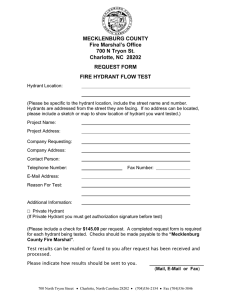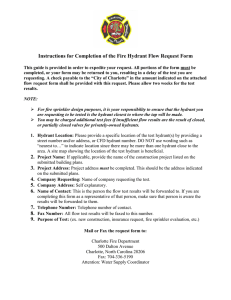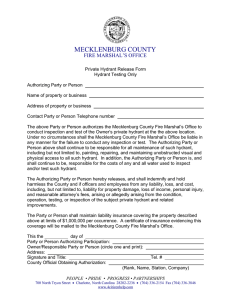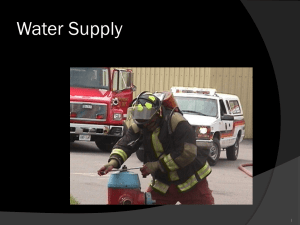Memo Charlotte-Mecklenburg Utilities
advertisement
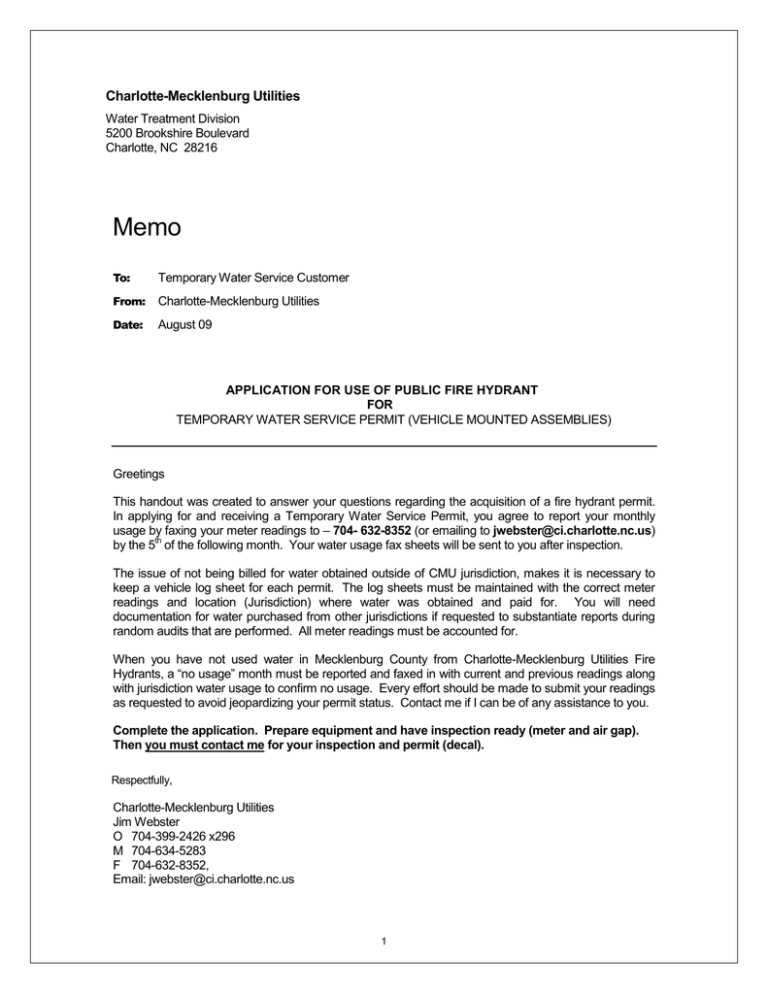
Charlotte-Mecklenburg Utilities Water Treatment Division 5200 Brookshire Boulevard Charlotte, NC 28216 Memo To: Temporary Water Service Customer From: Charlotte-Mecklenburg Utilities Date: August 09 APPLICATION FOR USE OF PUBLIC FIRE HYDRANT FOR TEMPORARY WATER SERVICE PERMIT (VEHICLE MOUNTED ASSEMBLIES) Greetings This handout was created to answer your questions regarding the acquisition of a fire hydrant permit. In applying for and receiving a Temporary Water Service Permit, you agree to report your monthly usage by faxing your meter readings to – 704- 632-8352 (or emailing to jwebster@ci.charlotte.nc.us) th by the 5 of the following month. Your water usage fax sheets will be sent to you after inspection. The issue of not being billed for water obtained outside of CMU jurisdiction, makes it is necessary to keep a vehicle log sheet for each permit. The log sheets must be maintained with the correct meter readings and location (Jurisdiction) where water was obtained and paid for. You will need documentation for water purchased from other jurisdictions if requested to substantiate reports during random audits that are performed. All meter readings must be accounted for. When you have not used water in Mecklenburg County from Charlotte-Mecklenburg Utilities Fire Hydrants, a “no usage” month must be reported and faxed in with current and previous readings along with jurisdiction water usage to confirm no usage. Every effort should be made to submit your readings as requested to avoid jeopardizing your permit status. Contact me if I can be of any assistance to you. Complete the application. Prepare equipment and have inspection ready (meter and air gap). Then you must contact me for your inspection and permit (decal). Respectfully, Charlotte-Mecklenburg Utilities Jim Webster O 704-399-2426 x296 M 704-634-5283 F 704-632-8352, Email: jwebster@ci.charlotte.nc.us 1 Definitions and information Air-gap separation: An unobstructed vertical distance through-the atmosphere between the lowest opening from any pipe or faucet supplying water from any source to a tank, plumbing fixture or other device and the flood level rim of the receptacle. An approved air-gap separation shall be at least double the nominal pipe size of the supply pipe. In no case shall the air-gap separation be less than one (1) inch. An approved air-gap separation is an effective method to prevent backflow and shall be considered as a backflow-prevention assembly Certified tester: An individual person who has proven his/her competency to test, repair and overhaul backflow-prevention assemblies of all types and to prepare reports on such assemblies as evidenced by the successful completion of a training program approved by the director. Human Consumption: Defined to include drinking, bathing, showering, cooking, dishwashing, and maintaining oral hygiene. Reduced-pressure principle assembly: An approved, properly functioning assembly containing two (2), independently acting check valves with a hydraulically operating, mechanically independent pressuredifferential relief valve located between the check valves and at the same time below the first check valve. The assembly must include properly located test cocks and tightly closing shutoff valves at each end of the assembly. This assembly is designed to protect against a high hazard, and must be one listed on CMU list of approved RP’s. Installation and testing of backflow-prevention assemblies Reference: Sec.23-102 Each backflow-prevention assembly required by this article must be functioning properly when installed. Each customer must test, maintain and repair each required backflow-prevention assembly, which is part of the customer's private water system. Such test(s) as may be prescribed by the director must be conducted by a certified tester immediately after the installation of each backflow-prevention assembly and on an annual basis thereafter. In addition, upon completing the repair of any backflow-prevention assembly, such assembly must be tested. Such test(s) must be approved by the director and must be made by a certified tester. Each customer must maintain a complete, written record of every repair and test of a required backflow-prevention assembly, which is part of such customer's private water system for at least seven (7) years. Such customer must send a copy of the record for each test or repair to the CMU within (30) thirtydays after the completion of each test or repair. Such records must be maintained on forms approved by the CMU. HYDRANT PROGRAM CHARGES INITIAL INSPECTION FEE MONTHLY PERMIT FEE WATER USAGE CHARGE $32.00 $ 3.00 PER PERMIT $ 2.04 Ccf USED Ccf Equivalent = 100 cubic feet 1 Ccf = 748 gallons 2 FIRE HYDRANT ACCESS AGREEMENT VECHICLE MOUNTED ASSEMBLIES The Fire Hydrant Access Program was established to provide the private/commercial customer authorized access to the public hydrants of Charlotte Mecklenburg Utilities (CMU). Water obtained from fire hydrants is NOT potable water; NOT SUITABLE FOR HUMAN CONSUMPTION. This authorization specifically excludes private fire hydrants and public hydrants that have been deemed unsuitable for all but emergency fire department use. Applicant must read and agree to the following provisions. 1) DESIGN SPECIFICATION a) Applicant must comply with all relevant Charlotte-Mecklenburg Code and CMU Backflow requirements b) Applicant must purchase and permanently mount CMU approved meter with strainer to vehicle in horizontal position with register facing up c) Tank fill line must incorporate an approved Reduced Pressure Principle Backflow Assembly (RP) or Air Gap to protect water system. d) The meter and backflow prevention must be hard piped or use approved hose with permanent band clamps e) Drain lines from tank can not have quick release hose coupling or treaded nipple. f) Required equipment must be fully functional and accurate. Testing, repair and maintenance of equipment are the owner’s responsibility and are to be paid for by owner. g) Malfunctioning equipment must be repaired promptly ● Meter must be repaired or replaced within three (3) days or permit is suspended ● Malfunctioning backflow assemblies must be repaired before equipment is connected to hydrant to obtain water. ● Notify CMU of any meter or register changes within one (1) day via fax or Email ● CMU reserves the right to inspect and flow test meters and backflow prevention assemblies randomly 2) FIRE HYDRANT PERMIT DECAL a) Applicant’s vehicle will be inspected by CMU agent to verify compliance and issue Fire Hydrant Access Permit for approved vehicles. Permit Decal will then be placed on vehicle in a highly visible location by the agent. Permit is valid only for the specific vehicle and equipment inspected. b) Modification to the (RP) backflow assembly or air gap, meter or piping must be inspected and approved. Failure to obtain inspection after alteration within three working days voids Fire Hydrant Access Permit. Operation of fire hydrant without a valid Fire Hydrant Access Permit is prohibited and punishable by civil fine. c) The Permit Decal is the property of CMU. Permit Decal must be surrendered to CMU when agreement is canceled by either CMU or the applicant. Permit Decals are valid until CMU implements a color change of the decal that will require all decals to be replaced. d) The permit is valid exclusively to the owner of the vehicle when it was submitted for inspection. 3) BILLING a) All water obtained from fire hydrants must flow through meter and air gap or Reduced Pressure Principle Backflow Prevention Assembly. b) CMU will provide each permit holder with an approved usage report form. A usage report is to be generated by the Customer for each permit issued and faxed or Emailed to CMU by the 5th day of each month accounting for all meter readings, usage and jurisdiction information for the previous month. c) To deduct water that is obtained from outside of CMU’s jurisdiction a vehicle log must kept. The log will contain accurate entries for date, location, jurisdiction and meter readings. Retain log sheets and receipts from other water providers for the prior eighteen months to substantiate usage report deductions during random audits that are preformed by CMU. d) A month with no usage must be reported just like a month with usage; the previous month’s ending meter reading and current month’s readings will be the same validating no usage. e) Failure to submit a usage report by the 5th of the month can jeopardize permits validity. A revoked permit will be assessed the appropriate fees and be billed to the Customer f) The Customer agrees to pay for the water used at the prevailing rate and the monthly permit charge for each reporting period. Billing is subject to the same rules and regulations as provided by the Charlotte City Code. Failure to pay the amount due will be reported as delinquent when appropriate and permit revoked. g) Worksite Meter Failure; maintain accurate bulk water record. Example - 6 loads at 2200 GAL/LOAD, add to monthly usage report. Corrective action must be taken to repair meter, refer section 1. g). h) CMU reserves the right to require meters to be read by a CMU representative at a specified location. 3 4) LIABILITY a) PROCEDURE FOR THE OPERATION OF PUBLIC FIRE HYDRANTS is a document distributed by CMU Backflow that describes the proper technique to use when operating a fire hydrant. This document must accompany any vehicle with a Fire Hydrant Permit Decal at all times. The Customer agrees to assume responsibility for damage to any fire hydrant used and/or damage to the connecting water system caused by improper operation of the hydrant. b) The Customer agrees to assume liability for personal/personnel safety when operating or using a public fire hydrant. The Customer is responsible for any property damage at or near the hydrant due to using the hydrant. 5) LIMITATIONS a) CMU reserves the right to limit use of specific hydrants. b) Water usage may be suspended or restricted during periods subject to freezing temperatures, mandatory/voluntary water conservation or due to any other event/phenomenon CMU considers significant enough to restrict use of fire hydrants. c) The Fire Hydrant Access Permit is issued exclusively for use to the applicant that the permit was granted to. Use of permit cannot be granted to any other individual or company. d) Failure to comply with any stipulation of this agreement by the Customer will be cause to revoke the permit. e) Any false statements or misrepresentations made during: the application process; condition, purpose or activity pursued by customer; water usage reports will result in an immediate revocation of permit. f) A civil penalty may be issued for a violation of any provision of this agreement. 4 PROCEDURE FOR THE OPERATION OF PUBLIC FIRE HYDRANT NEVER use hydrants if any kind of device is attached to them (1) Note: hoses used to obtain water from hydrants cannot be use for transferring no other liquids. (2) Only operate with an approved fire hydrant wrench. The operating nut on the top of the fire hydrant is a brass five-sided nut (1-1/4” pentagon) and will be damaged if operated with anything other than a fire hydrant wrench. If you damage the nut, you will be billed for the repairs. (3) Check the remaining nozzle caps to assure they are snug on the nozzles and will not blow off under pressure. (4) All city fire hydrants open by turning the operating mechanism in a clock-wise manner. Check the direction of the arrow stamped on the bonnet. (5) In no cases will hydrant hoses be allowed to traverse areas exposed to vehicular traffic. (6) The hydrant must be fully open. If the fire hydrant is opened less than full open, there is a danger that the fire hydrant could blow off the end of the lateral because the weep holes will not be completely closed which will allow water under pressure to erode the area around the fire hydrant. (7) If hose is left on hydrant to maintain a continuous flow of water, you must have a CMU approved In-Line Spring Loaded Check Valve at hydrant (prior to your hose connection), to prevent water in hose to return into hydrant. (8) You cannot throttle the flow of water using the fire hydrant. (9) After filling the tank, close the fire hydrant per the following steps. (10) It is very important that the fire hydrant be closed very slowly counter clock-wise. The way to assure that you are closing it slowly enough would be to take your hand completely off the wrench and count to five between turns. The reason for closing the fire hydrant slowly is to reduce water hammer in the distribution system, which can cause broken water mains and services. If you do cause this type of damage, you will be billed for the cost of making the necessary repairs. (11) When closing hydrants, do not apply extra leverage to operating wrench if hydrant valve fails to close entirely. An obstruction may be under the hydrant valve and further forcing of the hydrant would unnecessarily damage the rubber valve seats. Open and close hydrants several times to flush obstruction off seats. If after doing this, the hydrant does not close entirely, notify the Water Distribution Dispatcher at # 704-336-2564. (12) Remove hose and wrench from the fire hydrant. (13) Replace all caps and tighten on the fire hydrant before leaving. If caps are left off, debris can possibly get into the fire hydrant. This debris can cause problems when fighting fires; also may damage your own equipment if you use the fire hydrant again. Note: this procedure must be with the permitted vehicle at all times 5 EL PROCEDIMIENTO PARA EL FUNCIONAMIENTO DE BOCA DE AGUA DE FUEGO PÚBLICA NUNCA use las bocas de agua si cualquier amable de dispositivo se ata a ellos (1) La nota: las mangas obtenían el agua de las bocas de agua no puede ser ningún uso por no transferir otros líquidos. (2) Sólo opere con un tirón de boca de agua de fuego aceptado. La nuez que opera en la cima de la boca de agua de fuego es un latón cinco-estaba al lado de la nuez y se dañará si operó con algo de otra manera que un tirón de boca de agua de fuego. Si usted daña la nuez, usted se cargará en cuenta para las reparaciones. (3) El cheque las gorras de la boquilla restantes para asegurar ellos son cómodos en las boquillas y no soplarán fuera de bajo la presión. (4) Todas las bocas de agua de fuego de ciudad abren volviéndose el mecanismo que opera de una manera reloj-sabia. Verifique la dirección de la flecha estampada en el gorro. (5) En ningún caso las mangas de la boca de agua se permitirán a areas atravesado expuestas al tráfico vehicular. (6) La boca de agua debe ser totalmente abra. Si la boca de agua de fuego se abre menos de abatane abierto, hay un peligro de que la boca de agua de fuego podría soplar fuera del extremo el lateral porque el llore no se cerrarán los agujeros completamente qué permitirá el agua bajo la presión corroer el área alrededor de la boca de agua de fuego. (7) Si la manga se sale en la boca de agua para mantener un flujo continuo de agua, usted debe tener un CMU aprobado Primavera del En-línea Cargó la Válvula del Cheque a la boca de agua (prior a su conexión de la manga), para prevenir el agua en la manga volver en la boca de agua. (8) Usted no puede ahogarse el flujo de agua que usa la boca de agua de fuego. (9) Después de llenar el tanque, cierre la boca de agua de fuego por los pasos siguientes. (10) Es muy importante que la boca de agua de fuego se cierre muy lentamente el contador reloj-sabio. La manera de asegurar que usted está cerrándolo bastante despacio sería tomar su mano completamente fuera del tirón y contra hasta cinco entre los giros. La razón por cerrar la boca de agua de fuego despacio es reducir el martillo de agua en el sistema de la distribución que puede causar mains de agua rotos y servicios. Si usted causa este tipo de daño, usted se cargará en cuenta para el costo de hacer las reparaciones necesarias. (11) Al cerrar las bocas de agua, no aplica la influencia extra al tirón que opera si la válvula de la boca de agua falla completamente al cierre. Una obstrucción puede estar bajo la válvula de la boca de agua y forzando más allá de la boca de agua dañarían los asientos de válvula de caucho innecesariamente. Abra y las bocas de agua íntimas varios tiempos para vaciar la obstrucción fuera de los asientos. Si después de hacer esto, la boca de agua no cierra completamente, notifique al Distribuidor de Distribución de Agua a #704-336-2564. (12) Quite la manga y tire de de la boca de agua de fuego. (13) Reemplace todas las gorras y apriétese en la boca de agua de fuego antes de salir. Si las gorras se salen fuera de, las ruinas posiblemente pueden entrar en la boca de agua de fuego. Este ruinas pueden causar los problemas cuando los fuegos luchadores; también puede dañar su propio equipo si usted usa la boca de agua de fuego de nuevo. La nota: este procedimiento debe estar en todo momento con el vehículo permitido 6 CHARLOTTE-MECKLENBURG UTILITIES Vehicle # 67 Permit # Company name: 9998 6/7/2002 12345677 Sample Sheet / 123456-311112 Date 6/1/2002 Meter Serial # Sub-Division or Location Jurisdiction Meter reading start 4000 1 Green Place ME 2 " ME - 3 Green Place ME - 5 Orange Tree CC 4250 6/18/2002 6/23/2002 6/27/2002 ME 8 " ME - 9 Green Place ME - 4300 Blue Circle CC 12 " CC - 13 Blue Circle CC - 4400 100 4950 550 5050 100 5075 25 5100 25 - 15 Longwood ME 16 " ME - 17 Longwood ME - 21 4400 4950 Green Place ME 5050 - 20 6/29/2002 50 - 11 19 4300 - 18 6/28/2002 250 - Green Place 14 6/25/2002 - 7 10 6/19/2002 4250 - - 6 6/10/2002 Gallons or ccf used or # of loads - 4 6/9/2002 Meter reading end Bayridge ME 5075 - 22 - 23 - 24 - 25 - fax to 704-632-8352 before the 5th day each month 1100 AN (anson) - BM (belmont) - CC (city of concord) - CG (china grove) - CW (carolina water) - DA (dallas) - FM (fort mill) - GA (gaston) - HA (harrisburg) - HI (hickory) IR (iredell) - KA (kannapolis) - KR (krammerton) - LA (lancaster) - LI (lincoln) - ME (mecklenburg) - MH (mount holly) - MR (city of monroe) - MV (mooresville) - OT (other) - RH (rock hill) - SB (salisbury) - ST (stanley) - SV (statesville) - UN (union) - YO (york Note: 1 ccf = 748 gals Rev1 - 7/1/00 7 8 Horizon / strainer built-in Horizon / must purchase strainer separate HM 3" fire hydrant meter / must purchase strainer separate MMT-S Turbine / strainer built-in MMT-S Turbine / strainer built-in 3" Fire Hydrant Meter w/ SS internal strainer W-120 DRS / strainer built-in W-160 DRS / strainer built-in W-350 DRS / strainer built-in 125-W Fire Hydrant Meter w/ SS internal strainer NEPTUNE METERS, IF METER NEEDS TO BE REPLACE YOU MUST REPLACE WITH ONE FROM THE ABOVE LIST Hersey Hersey Hersey Master Meter Master Meter Master Meter Senus Senus Senus Senus NOTE: To have meter approved for list contact, FHC / CAFHM / strainer built-in FHS / strainer built-in FHP / strainer built-in PMT meter / PMS strainer HPM / strainer built-in Hendey Hendey Hendey Hendey Hendey Flange Flange Flange Threaded Flange Flange Threaded Flange Flange Threaded Threaded Threaded Threaded Threaded Threaded Flange Flange Threaded 910 270 2885 800 628 7515 Website: www.carolinameter.com Email: info@carolinameter.com Tom Walker 704 523 8163 704 394 5305 Contact fax 704-632-8352 Ferguson Waterworks Sumter, SC 800-726-0086 Consolidated Pipe & Supply 201 E 16th St Charlotte, NC 28206 Mainline Supply Company 7325 Old Statesville Road Charlotte, NC 28269 Mainline Supply Company, Rock Hill SC 803 775 7355 704 373 1880 800 489 1880 803 985 8888 888 609 7878 704 921 3004 Turn key fabrication available, air gap and uses CMU approved meters H&H Farm Machine Company Brian 7305 Brett Haigler Road 704 753 4919 Indian Trail, NC Carolina Meter & Supply, Inc. 265 Sloop Point Loop Road P.O. Box 400 Hampstead, NC 28443-0400 Water Treatment Div. 704-399 2426 X296, 1-1/2 2-0/0 3-0/0 3-0/0 2-0/0 3-0/0 3-0/0 2-0/0 3-0/0 3-0/0 2-1/2 3-0/0 3-0/0 3-0/0 3-0/0 2-0/0 3-0/0 3-0/0 Catawba Industrial Rubber Co. 4629 Dwight Evans Rd, Charlotte, NC Recordall Turbo 200 meter w/integral strainer Recordall Turbo 450 meter w/integral strainer Recordall Turbo 450 Fire Hydrant Meter / stainless screen Threaded Badger Badger Badger 3-0/0 HD Supply 901 Crafters Ln, Pineville, NC Distributor Recordall Turbo 450 Fire Hydrant Meter / stainless screen Threaded Coupling Badger 3-0/0 Size HT4000 Fire Hydrant Meter / stainless screen Model AMCO-Elster Brand There also may be special provisions to adhere to, inline check valve at hydrant, etc. Equipment less than 1200 gals must have inline valve after meter Equipment 500 gals and greater must use a 2-1/2in or 3in meter NOTES: ALL METERS MUST HAVE A STRAINER Charlotte-Mecklenburg Utilities Approved Vehicle Meters Consider winter when installing meter, to prevent freezing water needs to drain INSTALL METERS HORIZONTALLY Inlet pipe with 45° angle cut beneficial (heel longer than throat) to help with water flow AIR-GAP – Is the unobstructed vertical distance through the free atmosphere between the lowest opening from any pipe or faucet supplying water to a tank, plumbing fixture or other device and the flood level rim of the receptacle. An approved air-gap separation shall be at least double the nominal pipe size of the supply pipe. In no case shall the air-gap separation be less than one (1) inch. An approved air-gap separation is an effective method to prevent backflow and shall be considered as a backflow-prevention assembly REGISTER FACING UP Permanently mount the approved meter with strainer (see list) to the vehicle. Piping must be “hard-piped” or approved hose (multi-purpose water suction hose) with center punch clamps or equivalent (NO HOSE CLAMPS). No quick disconnects between meter and air gap in supply pipe. All water obtained from fire hydrant must pass thru approved meter and air gap or RP. Equipment with less than 1200-gallon capacity must have inline ball valve after meter depending on meter size. 9 Inlet pipe with 45° angle cut Air gap = 2 x pipe size from midpoint of angle cut to flood plane of tank 2in pipe = 4in air gap minimum 3in pipe = 6in air gap minimum Inlet pipe has notch cut as alternative to 45° angle cut Air gap = 2 x pipe size 10 Design Guidelines Supply line leads to air gap. The hose is secured using center punch clamps or equivalent Meter mounted horizontally with the register facing up Suction grade hose_ secured with center punch clamp Ball valve between meter and supply line to control water flow CMUD approved meter permanently mounted Cam-lock cap is highly functional EQUIPMENT MUST BE INSPECTED AND HAVE A PERMIT DECAL ISSUED BEFORE USING ANY HYDRANT IN THE CMUD DISTRIBUTION SYSTEM. USE IS LIMITED TO THE APPROVED HYDRANTS. 11 HYDRANT WATER IS NON-POTABLE CCF METER Black Numbers Painted or Revolving Are NOT Reported In The Reading You read and report this meter as 00940 Reading = 940 ccf’s One ccf = 748 gallons 12 C H A R L OT T E - M E C K L E N BU RG U T I L I T I E S Changing Hydrant Colors not allowed—each color has different meaning Pictured here is a hydrant with a pressure gauge which will monitor system pressure at times during the day. When gauges are connected like this, the Fire Hydrant must not be used unless a fire warrants its use. Please refrain from using these hydrants until the data collector is removed. If you need information on this activity please contact Mr. Barry Delzell with the Utilities Engineering Division at 704-399-2221. Blue Hydrants are not available for use by the Fire Department, citizens, or contractors. Only CharlotteMecklenburg Utilities staff is permitted to use these hydrants. H y d r an t s as pictured here must not be used unless a fire warrants its use. The color red is a code to all utility and Fire personnel, that if operated, the system in this area will be significantly affected. All use of this hydrant must be restricted to fire protection only. If you have question about why any particular hydrant has this designation contact the Utilities Operations Division at 704-336-2564 and speak with any available case worker. Hydrants with “out of service” rings on them also must not be used. A hydrant with this ring may pose a significant risk if operated. These hydrants will be on a schedule for repair. If you have a question about why any particular hyPurple hydrants are drant has this usually facing away designation conCharlottetact the Utilities from the street. Mecklenburg Operations DiviReclaimed water Utilities provides sion at 704-336instead of temporary water 2564 and speak drinkable / potable service for conwater flows through with any available struction. When that pipe and is not case worker. you see connecto be used for fire tions like these, fighting or commercial use. Reclaimed DON’T USE HYwater is water that was cleaned at a DRANT. They wastewater treatment plant and is will be under pressure and turning being used for irrigation. them off will effect the customers water use Private Hydrants are not for the use of any customer or activity contractor. These hydrants are only for fire protection and w h i c h n may be painted completely RED or have various colors i s o m e for the top and caps. These colors indicate they are private and shouldn't be use by contractors. Each color c a s e s represents certain conditions the fire department needs to c o u l d cause be aware of in the event they are responding to a fire. damage. These hydrants are only operated by utilities personnel. In the event of a fire the connections are made so the fire department can get quick access when needed. Backflow Prevention Protecting Safe Drinking Water 13 14 The hydrant pictured to the left is equipped with a Storz pumper nozzle. The Stroz nozzle is now the CMUD standard. The design is to ease fire hose connections. This style of hydrant may be used by an authorized permit holder if the hydrant satisfies all conditions specified in the Fire Hydrant Access Agreement. NEVER A PIPE WRENCH Always use a proper fire hydrant— something attached to it Never use any hydrant that already has a private water system Never use any private fire hydrant located within
